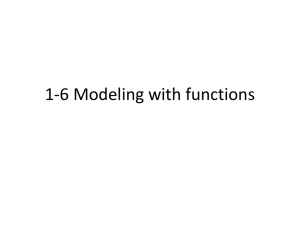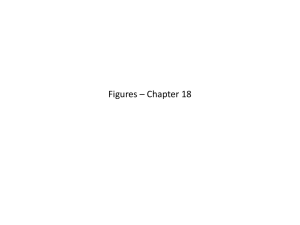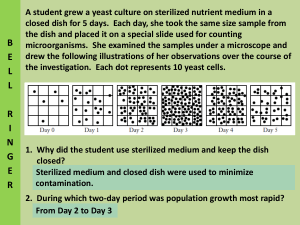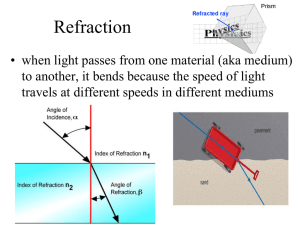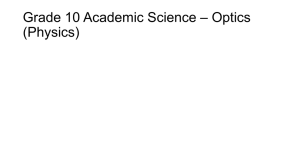MS Word - The Physics Classroom
advertisement
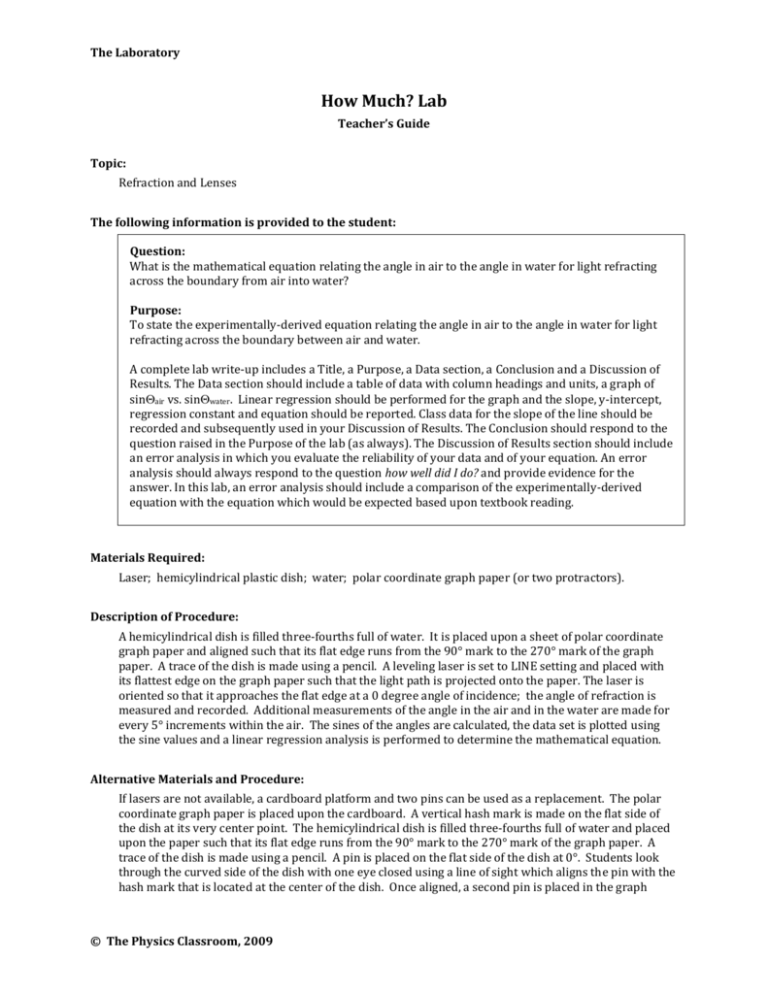
The Laboratory How Much? Lab Teacher’s Guide Topic: Refraction and Lenses The following information is provided to the student: Question: What is the mathematical equation relating the angle in air to the angle in water for light refracting across the boundary from air into water? Purpose: To state the experimentally-derived equation relating the angle in air to the angle in water for light refracting across the boundary between air and water. A complete lab write-up includes a Title, a Purpose, a Data section, a Conclusion and a Discussion of Results. The Data section should include a table of data with column headings and units, a graph of sinair vs. sinwater. Linear regression should be performed for the graph and the slope, y-intercept, regression constant and equation should be reported. Class data for the slope of the line should be recorded and subsequently used in your Discussion of Results. The Conclusion should respond to the question raised in the Purpose of the lab (as always). The Discussion of Results section should include an error analysis in which you evaluate the reliability of your data and of your equation. An error analysis should always respond to the question how well did I do? and provide evidence for the answer. In this lab, an error analysis should include a comparison of the experimentally-derived equation with the equation which would be expected based upon textbook reading. Materials Required: Laser; hemicylindrical plastic dish; water; polar coordinate graph paper (or two protractors). Description of Procedure: A hemicylindrical dish is filled three-fourths full of water. It is placed upon a sheet of polar coordinate graph paper and aligned such that its flat edge runs from the 90° mark to the 270° mark of the graph paper. A trace of the dish is made using a pencil. A leveling laser is set to LINE setting and placed with its flattest edge on the graph paper such that the light path is projected onto the paper. The laser is oriented so that it approaches the flat edge at a 0 degree angle of incidence; the angle of refraction is measured and recorded. Additional measurements of the angle in the air and in the water are made for every 5° increments within the air. The sines of the angles are calculated, the data set is plotted using the sine values and a linear regression analysis is performed to determine the mathematical equation. Alternative Materials and Procedure: If lasers are not available, a cardboard platform and two pins can be used as a replacement. The polar coordinate graph paper is placed upon the cardboard. A vertical hash mark is made on the flat side of the dish at its very center point. The hemicylindrical dish is filled three-fourths full of water and placed upon the paper such that its flat edge runs from the 90° mark to the 270° mark of the graph paper. A trace of the dish is made using a pencil. A pin is placed on the flat side of the dish at 0°. Students look through the curved side of the dish with one eye closed using a line of sight which aligns the pin with the hash mark that is located at the center of the dish. Once aligned, a second pin is placed in the graph © The Physics Classroom, 2009 The Laboratory paper along the line of sight such that the two pins and the hash mark are optically aligned with each other. The angle of incidence and refraction are recorded from the pin locations. The process is repeated for every 5° increments of the pin on the flat side of the dish. The sines of the angles are calculated, the data set is plotted using the sine values and a linear regression analysis is performed to determine the mathematical equation. Safety Concern: There is always a higher than usual level of risk associated with working in a science lab. Teachers should be aware of this and take the necessary precautions to insure that the working environment is as safe as possible. Light from lasers should never be pointed into a person's eye. Caution should be taken to avoid such mishaps. Student horseplay and off-task behaviors should not be tolerated. Suggestions, Precautions, Notes: 1. 2. 3. 4. 5. 6. 7. Inexpensive leveling lasers can be purchased at a home store. They often go on sale for $5 during the Christmas season. They possess the capability of projecting the laser as a line or a beam. If the price is right, consider picking up a class set for use in both reflection and refraction activities. Polar coordinate graph paper can be downloaded from many internet sites. For instance, try http://www.analyzemath.com/free_graph_paper/free_graph_paper.html The hemicylindrical plastic dishes described in the Materials and Procedure section are commonly available from science supply houses. As an example, consider the dish advertised by Arbor Scientific: http://www.arborsci.com/detail.aspx?ID=308 Instruct students to make every other measurement from the opposite side of the normal line. Any misalignment of the dish on the graph paper will be less significant if this alternating approach is used. If plotting the sine of the angle in air (vertical axis) vs. the sine of the angle in water (horizontal axis), then the slope will be the experimental value of the index of refraction of water. Errors are typically less than 3%. A subtle point but one worth mentioning to students involves the behavior of light at the curved side of the dish. As long as light approaches the flat side at a location which is at the center of the half-circle, then the light will approach the curved side along the normal line. There will be no refraction along the curved side of the dish at this angle of approach. Warn students in advance of the lab of the need to never direct laser light at another person's eye. Students who do not heed your warning should immediately be dismissed from the lab. Auxiliary Materials: None Scoring Rubric: RL4. How Much? Lab Included, labeled and organized all parts of the lab report. Data section includes an organized table of air and water values; table headings and units are included. A plot of sinair vs. sinwater is sketched; results of the linear regression analysis (slope, y-intercept, R value) and the equation is reported. Equation avoids y's and x's and includes the symbols of the plotted quantities. Conclusion reports the experimentally-derived equation. Discussion of Results accurately evaluates the reliability of the equation commenting on the slope value and the regression constant from the linear © The Physics Classroom, 2009 Score _____/_____ The Laboratory analysis. The experimentally-derived equation is compared to the equation which would be expected based upon textbook readings. Connections to The Physics Classroom Tutorial: The following reading is a suitable accompaniment to this lab: http://www.physicsclassroom.com/Class/refrn/u14l2b.cfm http://www.physicsclassroom.com/Class/refrn/u14l2d.cfm Connections to Minds on Physics Internet Modules: Sublevel 4 of the Refraction and Lenses module is a suitable accompaniment to this lab: http://www.physicsclassroom.com/mop/module.cfm © The Physics Classroom, 2009
